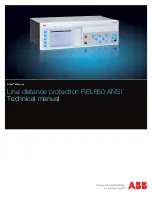
Functions
2.3 Differential Protection
SIPROTEC, 7SD5, Manual
C53000-G1176-C169-5, Release date 02.2011
93
2.3
Differential Protection
The differential protection is the first main protection function of the device. It is based on current comparison.
For this, one device must be installed at each end of the zone to be protected. The devices exchange their
measured quantities via communication links and compares the received currents with their own values. In
case of an internal fault the allocated circuit breaker is tripped.
Depending on the version ordered, 7SD5 is designed for protected objects with up to 6 ends. Thus, with ex-
ception of normal lines, three and multi-branch lines can also be protected with or without connected transform-
ers in block as well as small busbars. The protected zone is selectively limited by the current transformers at
its ends.
The differential protection (Main1) can be configured in parallel to distance protection (Main2), or as sole pro-
tection function (Main Only) (see Section 2.1.1.3).
2.3.1
Functional Description
Basic principle with two ends
The differential protection is based on current comparison. It makes use of the fact that e.g. a line section L
(Figure 2-22) always carries the same current i (dashed line) at its two ends in healthy operation. This current
flows into one side of the considered zone and leaves it again on the other side. A difference in current is a
clear indication of a fault within this line section. If the actual current transformation ratios are the same, the
secondary windings of the current transformers
CT1
and
CT2
at the line ends can be connected to form a
closed electric circuit with a secondary current
I
; a measuring element
M
which is connected to the electrical
balance point remains at zero current in healthy operation.
When a fault occurs in the zone limited by the transformers, a current i
1
+ i
2
which is proportional to the fault
currents
I
1
+
I
2
flowing in from both sides is fed to the measuring element. As a result, the simple circuit shown
in Figure 2-22 ensures a reliable tripping of the protection if the fault current flowing into the protected zone
during a fault is high enough for the measuring element
M
to respond.
Figure 2-22
Basic principle of the differential protection for a line with two ends
Содержание SIPROTEC
Страница 20: ...Contents SIPROTEC 7SD5 Manual C53000 G1176 C169 5 Release date 02 2011 20 ...
Страница 351: ...Functions 2 18 Synchronism and Voltage Check optional SIPROTEC 7SD5 Manual C53000 G1176 C169 5 Release date 02 2011 351 ...
Страница 494: ...Functions 2 27 Command Processing SIPROTEC 7SD5 Manual C53000 G1176 C169 5 Release date 02 2011 494 ...
Страница 640: ...Technical Data 4 27 Dimensions SIPROTEC 7SD5 Manual C53000 G1176 C169 5 Release date 02 2011 640 ...
Страница 657: ...Appendix A 2 Terminal Assignments SIPROTEC 7SD5 Manual C53000 G1176 C169 5 Release date 02 2011 657 7SD5 W ...
Страница 754: ...Appendix A 10 Measured Values SIPROTEC 7SD5 Manual C53000 G1176 C169 5 Release date 02 2011 754 ...
Страница 756: ...Literature SIPROTEC 7SD5 Manual C53000 G1176 C169 5 Release date 02 2011 756 ...
Страница 768: ...Glossary SIPROTEC 7SD5 Manual C53000 G1176 C169 5 Release date 02 2011 768 ...
















































